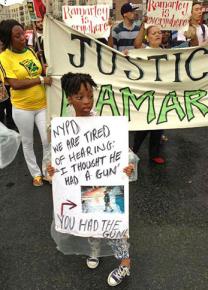Why did Ramarley have to die?
reports from New York City on the latest efforts by family, friends and supporters to win justice for a teenager murdered by the NYPD in 2012.
DOZENS OF activists gathered in downtown New York City on August 20 to demand justice for Ramarley Graham. In front of the New York office of the U.S. Department of Justice (DOJ), chants of "Protect and serve? That's a lie! Why'd Ramarley have to die?" and "DOJ! Prosecute now!" rang out as a #BlackLivesMatter banner was unfolded on the front steps of the federal building.
Family and friends gave moving speeches that captivated fellow protesters and captured the attention of passersby who may not have heard about the case that began three years ago.
On February 2, 2012, 18-year-old Ramarley Graham was shot and killed in his Bronx home by New York City police. A narcotics unit had earlier witnessed Ramarley "adjust his waistband" outside of a local store and took that as a sign that he had a gun. Cops followed him home and, without a warrant, broke in and shot Ramarley in his bathroom, with his grandmother and little brother nearby. Needless to say, no gun or drugs were found.
During the entire three-year investigation of Ramarley's murder, the officer who killed him, Richard Haste, has yet to see the inside of a courtroom, let alone a jail cell. Constance Malcolm and Frank Graham, Ramarley's parents, were at the protest to demand that much. "We will not go away!" Frank bellowed to the crowd. "We will not go until we get justice for Ramarley."

Constance recalled the night her son was murdered. She told the crowd how Ramarley's grandmother, a witness to the shooting, was taken into police custody and held against her will for hours as she grieved for her dead grandson. During the time that she was held without a lawyer, she could hear police officers laughing.
Danette Chavis, mother of NYPD murder victim Gregory Chavis, also attended the protest and recounted how Haste left the courtroom to applause by his fellow officers after the initial criminal charge against him was throw out on a technicality. "What kind of culture do they have in the NYPD where they applaud when a man gets off on a murder charge?" she asked.
This was the question shouted at local police who gathered to maintain "crowd control." With Mayor Bill de Basio putting 1,300 more cops on the streets alongside decrepit and crumbling schools, we should all be asking: "What kind of culture do we have?"
Another speaker pointed to the hypocrisy of cops who claim to be the "good" ones as opposed to the "bad apples." "If you see your partner commit a crime, and you say nothing, you're just a wrong as they are," said the speaker.
The DOJ took up the case when the city decided not to mount a second prosecution of Haste. But the Feds have been dragging their feet, and Constance hasn't received any updates regarding the DOJ's progress with the case. In addition to raising general awareness about widespread police abuse, the protest was called in order to pressure the DOJ to prosecute Haste and the other officer responsible for Ramarley Graham's death.


